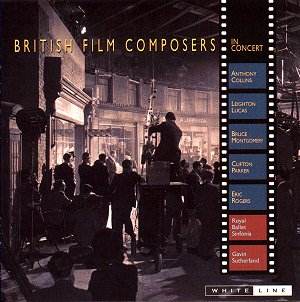This interesting compilation covers the work
of less celebrated British film composers. Some of the pieces
have theatre/ballet connotations hence presumably the interest
of the Royal Ballet Sinfonia.
I will cover the Eric Rogers work first which
is the most substantial on this CD (approx. 24 minutes). Rogers
is best remembered for his music for the British ‘Carry On’ series
of broad comedies. His Palladium Symphony, ostensibly influenced
by the variety theatre (it was dedicated to his wife Betty who
was a dancer) it might also be regarded as a brilliant parody
of Hollywood film music. Its opening movement ‘Rhapsody’ opens
with the sort of sweeping music one associated with Max Steiner
in full romantic flow continuing with Mickey-Mouse material that
might have been used for some slapstick routine. ‘Spring-time’,
the second movement, has lush Korngold/Steiner extravagance and
the Scherzo is almost laughing set to music influenced, perhaps
inspired, by Korngold buffoonery or Ealing comedy music. The ‘Finale’
conjures up memories of the sort of towering dramatic scores Max
Steiner created for Bette Davis’s pictures. Great fun this work.
The programme kicks off with Clifton Parker’s
Thieves Carnival, a cocky, cheeky piece reminiscent of
Constant Lambert. Two bright castanet-filled, Latin pieces, by
Parker, follow: ‘Alla spagnola’ is perky and sexy while the less
frenetic ‘Alla cubana’ has Ravelian echoes and is more wistful
and tender. Parker’s film score credits include: The Blue
Lagoon (1948); Treasure Island (1949); The Wooden
Horse (1950) and Sink the Bismark (1959).
Leighton Lucas was a largely self-taught composer
and initially a ballet dancer. He was part of Louis Levy’s ‘school’
at Gainsborough before branching out on his own with films like
Hitchcock’s Stage Fright (1950) and a number of war epics
like The Dam Busters (1954) and Ice Cold in Alex
(1958). His Ballet de la Reine is a suite taken from sketches
for an unperformed ballet, composed in 1949, and intended for
the Edinburgh Ballet Club. The composer retains a 16th
century flavour to the dances, many of the melodies being paraphrases
of Dowland and other lutenists of the period while still retaining
originality. As Philip Lane says in his valuable notes, this music
is a gentle mix of Warlock’s Capriol Suite and Ravel’s
Tombeau de Couperin. The suite commences in majesty with
‘Entrée et pavan’. ‘Air de luth’ is a delicious confection
with beguiling material for harp and oboe. ‘Courante’ is serenely
pastoral, a gentle rustic dance ending in a sigh. ‘Tordion’ is
a softly lilting enchantment and ‘Sarabande’ a stately deeply
felt progression (very much ‘period Gainsborough’ film music this
movement). Finally ending in upbeat merriment, ‘Bransles’ is a
dance with Gaelic overtones.
Sutherland and the Royal Ballet Sinfonia give
a lusty reading of Anthony Collins’ very stirring ‘Battle March’
that forms the first movement of the Eire Suite. The lovely
Reverie that follows recalls, in sentimental nostalgic mood, the
misty Mountains of Mourne – in a gorgeous arrangement of the famous
Irish melody. And it is another arrangement of another well-known
Irish tune, the jolly ‘Phil the Fluter’s Ball’, that rounds off
the suite.
Anthony Collins recorded a wonderful set of Sibelius
symphonies for Decca and wrote some memorable light music miniatures
like Vanity Fair. His film music credits include: Victoria
the Great (1937), Nurse Edith Cavell (AAN 1939),
Irene (AAN 1940), Tom Brown’s Schooldays (1940)
and The Lady with the Lamp (1951).
Like Eric Rogers, Bruce Montgomery was associated
with the ‘Carry On’ series of films. His Scottish Aubade
and Scottish Lullaby are concert works derived from two
films: a documentary, Scottish Highlands (1952) and The
Kidnappers (1953) set in Nova Scotia. The Aubade is
nicely evocative and lyrical with material of shimmering beauty
and suggestive of dramatic vistas. The Lullaby is frolicsome
and sentimental.
Delightful light music by less celebrated British
film composers.
Ian Lace


![]() Royal Ballet Sinfonia/Gavin
Sunderland
Royal Ballet Sinfonia/Gavin
Sunderland ![]() ASV WHITE LINE CD WHL
2145 [71:48]
ASV WHITE LINE CD WHL
2145 [71:48]